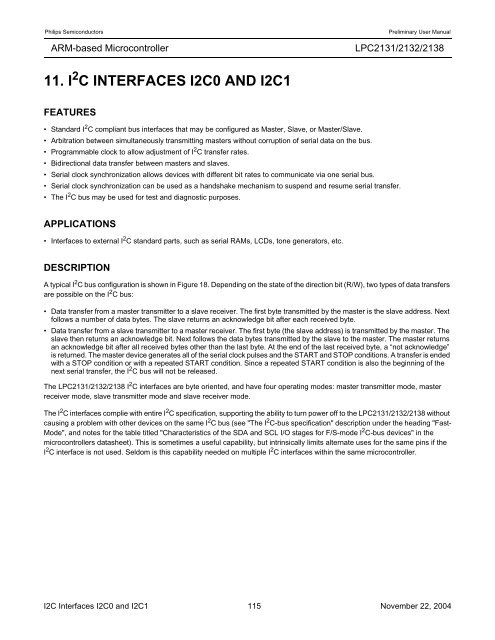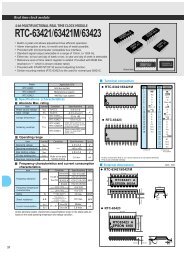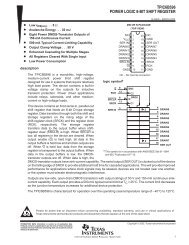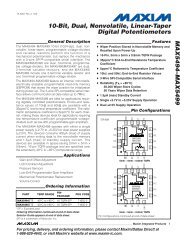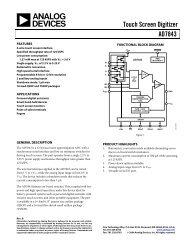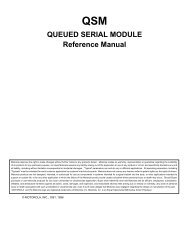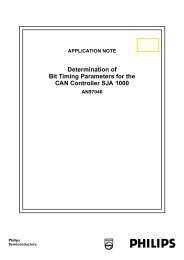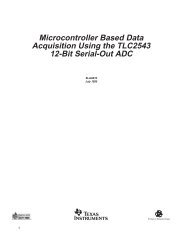You also want an ePaper? Increase the reach of your titles
YUMPU automatically turns print PDFs into web optimized ePapers that Google loves.
Philips Semiconductors Preliminary <strong>User</strong> <strong>Manual</strong><br />
ARM-based Microcontroller<br />
11. I 2 C INTERFACES I2C0 AND I2C1<br />
FEATURES<br />
<strong>LPC2131</strong>/<strong>2132</strong>/<strong>2138</strong><br />
Standard I 2 C compliant bus interfaces that may be configured as Master, Slave, or Master/Slave.<br />
Arbitration between simultaneously transmitting masters without corruption of serial data on the bus.<br />
Programmable clock to allow adjustment of I 2C transfer rates.<br />
Bidirectional data transfer between masters and slaves.<br />
Serial clock synchronization allows devices with different bit rates to communicate via one serial bus.<br />
Serial clock synchronization can be used as a handshake mechanism to suspend and resume serial transfer.<br />
The I 2 C bus may be used for test and diagnostic purposes.<br />
APPLICATIONS<br />
Interfaces to external I 2 C standard parts, such as serial RAMs, LCDs, tone generators, etc.<br />
DESCRIPTION<br />
A typical I 2 C bus configuration is shown in Figure 18. Depending on the state of the direction bit (R/W), two types of data transfers<br />
are possible on the I 2 C bus:<br />
Data transfer from a master transmitter to a slave receiver. The first byte transmitted by the master is the slave address. Next<br />
follows a number of data bytes. The slave returns an acknowledge bit after each received byte.<br />
Data transfer from a slave transmitter to a master receiver. The first byte (the slave address) is transmitted by the master. The<br />
slave then returns an acknowledge bit. Next follows the data bytes transmitted by the slave to the master. The master returns<br />
an acknowledge bit after all received bytes other than the last byte. At the end of the last received byte, a “not acknowledge”<br />
is returned. The master device generates all of the serial clock pulses and the START and STOP conditions. A transfer is ended<br />
with a STOP condition or with a repeated START condition. Since a repeated START condition is also the beginning of the<br />
next serial transfer, the I 2C bus will not be released.<br />
The <strong>LPC2131</strong>/<strong>2132</strong>/<strong>2138</strong> I 2 C interfaces are byte oriented, and have four operating modes: master transmitter mode, master<br />
receiver mode, slave transmitter mode and slave receiver mode.<br />
The I 2 C interfaces complie with entire I 2 C specification, supporting the ability to turn power off to the <strong>LPC2131</strong>/<strong>2132</strong>/<strong>2138</strong> without<br />
causing a problem with other devices on the same I 2 C bus (see "The I 2 C-bus specification" description under the heading "Fast-<br />
Mode", and notes for the table titled "Characteristics of the SDA and SCL I/O stages for F/S-mode I 2 C-bus devices" in the<br />
microcontrollers datasheet). This is sometimes a useful capability, but intrinsically limits alternate uses for the same pins if the<br />
I 2 C interface is not used. Seldom is this capability needed on multiple I 2 C interfaces within the same microcontroller.<br />
I2C Interfaces I2C0 and I2C1 115 November 22, 2004


